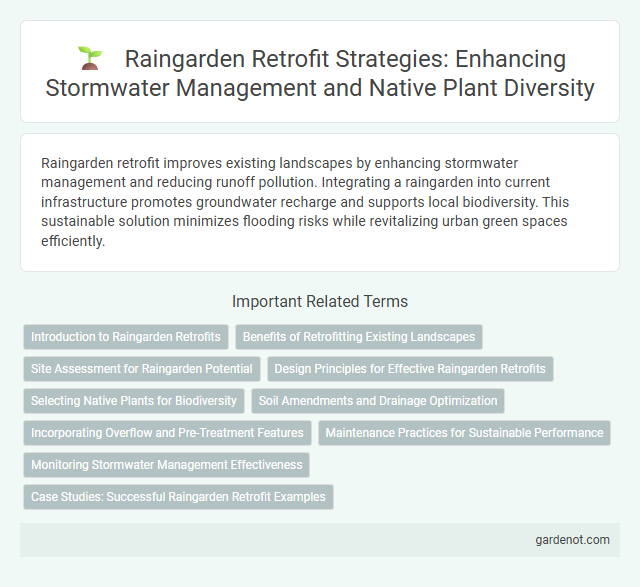Raingarden retrofit improves existing landscapes by enhancing stormwater management and reducing runoff pollution. Integrating a raingarden into current infrastructure promotes groundwater recharge and supports local biodiversity. This sustainable solution minimizes flooding risks while revitalizing urban green spaces efficiently.
Introduction to Raingarden Retrofits
Raingarden retrofits transform existing landscapes by integrating engineered depressions filled with native plants to manage stormwater runoff effectively. These systems reduce urban flooding, improve water quality by filtering pollutants, and enhance habitat diversity in developed areas. Retrofitting raingardens optimizes stormwater management without requiring extensive new land, making them practical for urban sustainability initiatives.
Benefits of Retrofitting Existing Landscapes
Retrofitting existing landscapes with rain gardens improves stormwater management by reducing runoff and filtering pollutants, enhancing water quality sustainably. These installations increase urban green space, promote biodiversity by providing habitat for native plants and wildlife, and mitigate urban heat island effects. Implementing rain garden retrofits supports compliance with municipal stormwater regulations and can reduce long-term landscaping and drainage maintenance costs.
Site Assessment for Raingarden Potential
Site assessment for raingarden retrofit involves evaluating soil permeability, slope, and existing drainage patterns to determine optimal placement and design. Identifying areas with poor drainage and frequent surface runoff ensures effective infiltration and water quality improvement. Mapping impervious surfaces and proximity to downspouts enhances raingarden performance by maximizing stormwater capture and reducing flooding risks.
Design Principles for Effective Raingarden Retrofits
Raingarden retrofit design principles emphasize maximizing infiltration by selecting appropriate soil media and ensuring proper slope to capture runoff effectively. Incorporating native plants with deep root systems improves pollutant filtration and enhances stormwater absorption. Proper sizing based on watershed area and rainfall intensity is critical to optimize performance and prevent overflow.
Selecting Native Plants for Biodiversity
Selecting native plants for a raingarden retrofit enhances biodiversity by supporting local wildlife and improving ecosystem stability. Native species are adapted to regional climate and soil conditions, reducing maintenance and increasing resilience against pests and diseases. Incorporating a diverse mix of native grasses, shrubs, and flowering plants promotes habitat variety, attracts pollinators, and optimizes water filtration in the raingarden.
Soil Amendments and Drainage Optimization
Raingarden retrofit projects prioritize soil amendments by incorporating organic matter such as compost and biochar to enhance soil permeability and nutrient retention, promoting healthier plant growth and effective stormwater infiltration. Drainage optimization involves redesigning inlet and outlet structures to prevent waterlogging and ensure consistent flow rates, often using gravel layers or perforated pipes to facilitate subsurface drainage. These measures collectively improve the raingarden's capacity to manage runoff, reduce erosion, and increase pollutant removal efficiency.
Incorporating Overflow and Pre-Treatment Features
Incorporating overflow and pre-treatment features in a raingarden retrofit enhances stormwater management by preventing flooding and removing pollutants before water infiltrates the soil. Installing overflow structures directs excess water safely to nearby drainage systems during heavy rainfall, reducing erosion and property damage. Pre-treatment components such as sediment forebays or vegetated filter strips capture debris, sediments, and nutrients, improving water quality and promoting healthier plant growth within the raingarden.
Maintenance Practices for Sustainable Performance
Raingarden retrofit maintenance practices are essential for ensuring sustainable stormwater management and enhancing urban green infrastructure. Key activities include regular inspection for sediment buildup, weeding invasive species, and replenishing mulch to maintain infiltration capacity and plant health. Scheduled maintenance also involves monitoring plant vigor and soil moisture levels to optimize pollutant removal and extend the functional lifespan of retrofitted raingardens.
Monitoring Stormwater Management Effectiveness
Rain garden retrofit projects significantly enhance stormwater management by improving infiltration and reducing runoff volume and pollutant loads. Monitoring effectiveness involves using sensors and water quality testing to track parameters such as flow rates, sediment levels, and nutrient concentrations before and after installation. Data-driven assessments guide maintenance schedules and retrofit adjustments, ensuring optimized stormwater retention and improved urban water quality.
Case Studies: Successful Raingarden Retrofit Examples
Case studies of raingarden retrofits highlight significant reductions in urban stormwater runoff, demonstrating improvements in water quality and flood mitigation. Projects in Seattle and Portland showcase the effectiveness of integrating raingardens into existing landscapes, achieving up to 90% pollutant removal and enhanced groundwater recharge. These examples emphasize best practices in soil amendment, native plant selection, and strategic placement for maximizing ecological and community benefits.
Raingarden retrofit Infographic

 gardenot.com
gardenot.com